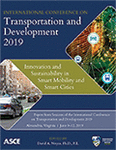International Conference on Transportation and Development 2019
Validation of Traffic Simulation Model Output Using High-Resolution Video by Unmanned Aerial Vehicles
Publication: International Conference on Transportation and Development 2019: Innovation and Sustainability in Smart Mobility and Smart Cities
ABSTRACT
Traffic simulation models can provide a cost-effective and flexible alternative to evaluate the various roadway designs and traffic management alternatives. To do so, we first need to ensure that the models are appropriately calibrated to reflect the existing conditions. The use of unmanned aerial vehicle (UAV) has gained particular attention in the transportation infrastructure industry. On a nationwide scale, there has been a trend to incorporate UAV in traffic operations such as traffic monitoring and infrastructure management activities which include bridge and roadway inspections. The goal of this study is to evaluate the effectiveness of utilizing UAV to validate traffic simulation model outputs. To that end, two simulation models of an intersection in Auburn, Alabama, were developed using Synchro and VISSIM simulation software. The high-resolution video and photographic data collected by UAV were employed to validate that the models reflect the existing traffic operations at the study intersection. Simulation models were calibrated and compared with results obtained from drone videos. The results showed that UAVs have the potential to improve the validation procedure of traffic simulation by providing complete pictures of traffic movements at entire intersections.
Get full access to this chapter
View all available purchase options and get full access to this chapter.
ACKNOWLEDGMENT
The authors would like to acknowledge Dr. Wesley Zech in the Department of Civil Engineering at Auburn University, AL, for sharing UAV videos used in this study.
REFERENCES
American Association of State Highway and Transportation Officials (AASHTO). (2016). State DOTs Using Drones to Improve Safety, Collect Data and Cut Costs. Washington, D.C. <http://www.aashtojournal.org/Pages/NewsReleaseDetail.aspx?NewsReleaseID=1466>.
Barfuss, S. L., Jensen, A., & Clemens, S. (2012). Evaluation and development of unmanned aircraft (UAV) for UDOT needs(No. UT-12.08).
Barmpounakis, E. N., Vlahogianni, E. I., & Golias, J. C. (2016). Extracting kinematic characteristics from unmanned aerial vehicles. In Transportation Research Board 95th Annual Meeting(No. 16-3429).
Brooks, C., Dobson, R. J., Banach, D. M., Dean, D., Oommen, T., Wolf, R. E., Havens, T., & Hart, B. (2015). Evaluating the Use of Unmanned Aerial Vehicles for Transportation Purposes(No. RC-1616). Michigan Tech Research Institute, Ann Arbor, Michigan.
Connecticut Department of Transportation (CTDOT). (2016). CTDOT to Test Unmanned Aerial Vehicle System (UAV) for Bridge Inspection, Newington, Connecticut.
Day, D. (2016). Unmanned Aerial Vehicles (UAVs) in Delaware. ITE Mid-Colonial Conference, Wilmington, Delaware.
De Bruin, A., & Booysen, T. (2015). Drone-based traffic flow estimation and tracking using computer vision: transportation engineering. Civil Engineering= Siviele Ingenieurswese, 23(8), 48-50.
Florida Department of Transportation (FDOT). (2016). Manual on Uniform Traffic Studies. <https://fdotwww.blob.core.windows.net/sitefinity/docs/default-source/content/traffic/trafficservices/studies/muts/muts-final-01.2016.pdf?sfvrsn=7f52579e_0>.
Hainen, A. M., Stevens, A. L., Day, C. M., Li, H., Mackey, J., Luker, M., & Bullock, D. M. (2015). Performance Measures for Optimizing Diverging Interchanges and Outcome Assessment with Drone Video. Transportation Research Record: Journal of the Transportation Research Board, (2487), 31-43.
Irizarry, J., & Johnson, E. N. (2014). Feasibility study to determine the economic and operational benefits of utilizing unmanned aerial vehicles (UAVs).
Kanistras, K., Martins, G., Rutherford, M. J., & Valavanis, K. P. (2015). Survey of unmanned aerial vehicles (UAVs) for traffic monitoring. In Handbook of unmanned aerial vehicles(pp. 2643-2666). Springer Netherlands.
Karpowicz, R. (2014). The Use of Unmanned Aerial Systems for Steep Terrain Investigations. California Department of Transportation (Caltrans), Sacramento, California.
Khan, M. A., Ectors, W., Bellemans, T., Janssens, D., & Wets, G. (2017a). Unmanned Aerial Vehicle-Based Traffic Analysis: Methodological Framework for Automated Multivehicle Trajectory Extraction. Transportation Research Record: Journal of the Transportation Research Board, (2626), 25-33.
Khan, M. A., Ectors, W., Bellemans, T., Janssens, D., & Wets, G. (2017b). UAV-Based Traffic Analysis: A Universal Guiding Framework Based on Literature Survey. Transportation Research Procedia, 22, 541-550.
Lewis, R., & Williams, T. (2014). Unmanned Aerial Systems: Breaking Through the Barriers. Ohio Department of Transportation (ODOT), Columbus, Ohio.
Lovelace, B. (2015). Unmanned Aerial Vehicle Bridge Inspection Demonstration Project. Minnesota Department of Transportation (MnDOT), Saint Paul, Minnesota.
North Carolina Department of Transportation (NCDOT). (2016). Operational Unmanned Aircraft Systems (UAS) in North Carolina, Raleigh, North Carolina.
Olmsted, S. (2016). Using LiDAR and Drone Data Collection to Advance Hydraulic Engineering. Arizona Department of Transportation (ADOT), Phoenix, Arizona.
Otero, L. D., Gagliardo, N., Dalli, D., Huang, W. H., & Cosentino, P. (2015). Proof of Concept for Using Unmanned Aerial Vehicles for High Mast Pole and Bridge Inspections. Contract BDV28, 977-02.
Park, B., & Schneeberger, J. (2003). Microscopic simulation model calibration and validation: case study of VISSIM simulation model for a coordinated actuated signal system. Transportation Research Record: Journal of the Transportation Research Board, (1856), 185-192.
Puri, A. (2005). A survey of unmanned aerial vehicles (UAV) for traffic surveillance. Department of computer science and engineering, University of South Florida, 1-29.
Vermont Unmanned Aircraft Systems (VUAS). (2016). UAS Mapping Spring Floods in VT. University of Vermont, Burlington, Vermont.
West Virginia Public. (2015). W.V. Transportation Department Buys Second Drone. <http://wvpublic.org/post/wva-transportation-department-buys-second-drone>.
Yuyang, Z., Yi, G., Lin, Y., and Xiao-Yong, L. (2015). Calculation and analysis of the traffic parameters of vehicles based on the wide-area drone video. Transportation System Engineering and Information, 15 (6), 67-73.
Information & Authors
Information
Published In
International Conference on Transportation and Development 2019: Innovation and Sustainability in Smart Mobility and Smart Cities
Pages: 135 - 147
Editor: David A. Noyce, Ph.D., University of Wisconsin–Madison
ISBN (Online): 978-0-7844-8258-2
Copyright
© 2019 American Society of Civil Engineers.
History
Published online: Aug 28, 2019
Authors
Metrics & Citations
Metrics
Citations
Download citation
If you have the appropriate software installed, you can download article citation data to the citation manager of your choice. Simply select your manager software from the list below and click Download.
